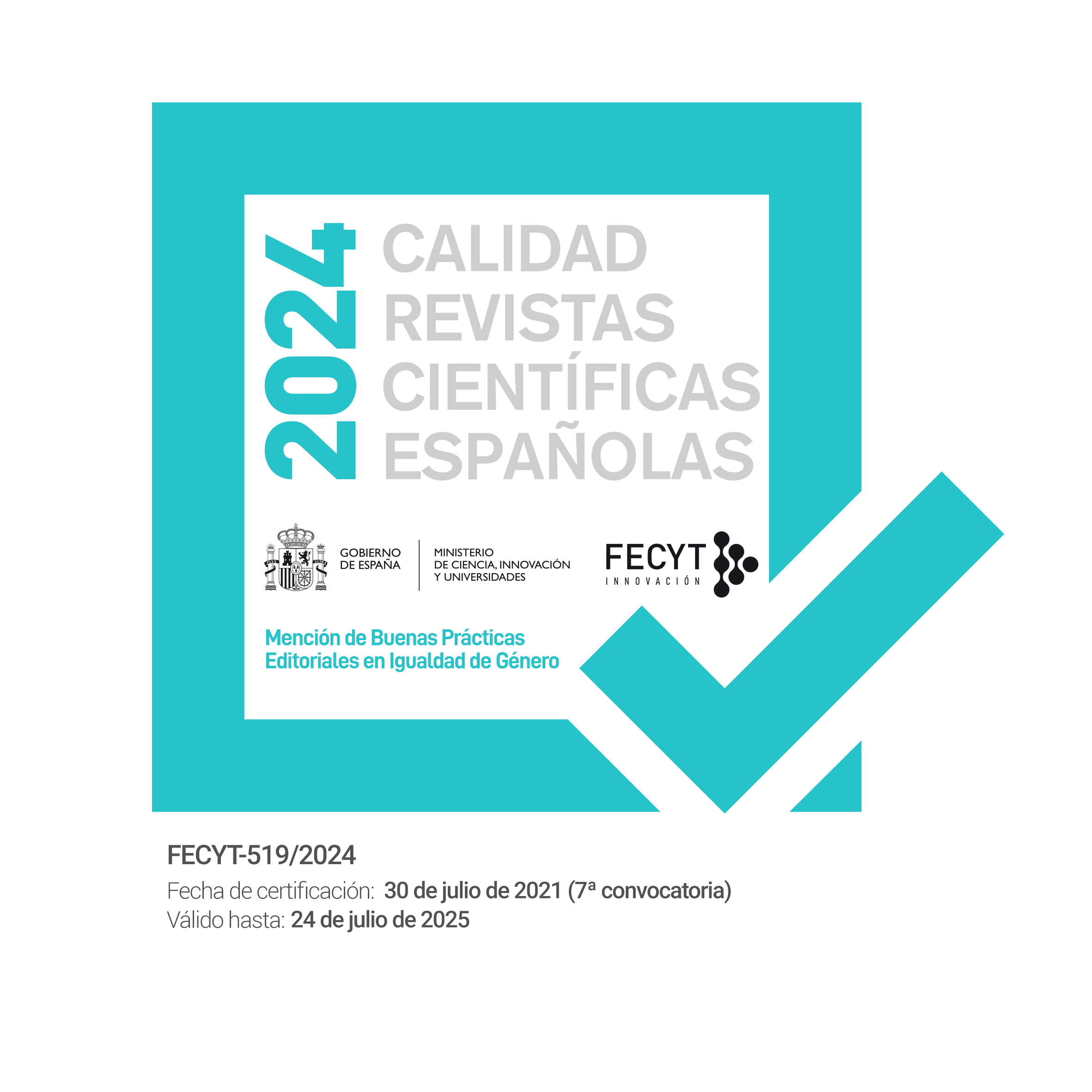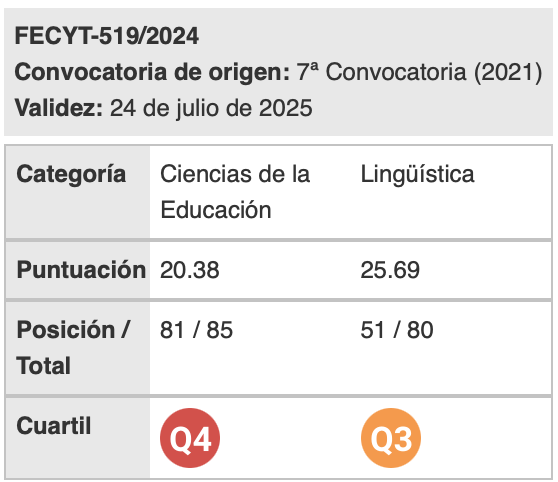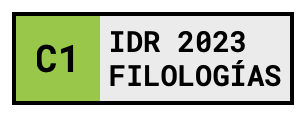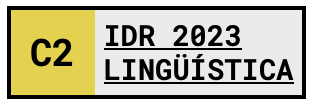Bewertungsinstrument für die Analyse von Materialien de Niveaustufen A1 bis B1 der Kurse „Deutsch aks Fremdsprache“
Keywords:
language teaching, teaching material, materials analysis, CEFR levels, evaluation toolAbstract
Abstract
The contents offered by the didactic materials do not necessarily correspond to those required for reference levels A1 to B1 of the German language according to the Goethe Institut definitions. The lowest requiered level for professional purposes is B1, which provides some freedom in terms of the order of presentation of content for material designers such as large publishers. By applying a quantitative assessment tool to three educational materials from different publishers, it is verified that the degree of content coverage required by the Goethe Institut increases if the contents treated between levels A1 to B1 are computed together. Even so, the results have revealed that none of the materials studied meets a satisfactory percentage in terms of the totality of what is required by the Goethe Institute.
Downloads
References
Aguilar Juárez, I., & Morales Gamboa, R. (2011). “Análisis de los Modelos de producción de CODIE (Contenidos Digitales Educativos)”. In T. Morales Reynoso, C. Serrano Barquín, J. M. Serrano García, D. A. Miranda Gracía, E. Estrada Laredo, P. Troche Hernández, & A. Rojas García (Eds.), 1er Coloquio Internacional Aplicaciones educativas de las Tecnologías de la Información y la Comunicación, Universidad de Guadalajara, 569–583. https://www.academia.edu/11874006/Análisis_de_los_ Modelos_de_producción_de_CODIE_Contenidos_Digitales_Educativos_ [2.5.2020].
Bhushan, N., & Rai, K. (2004). Strategic decision making. Appling the Analytic Hierarchy Process. London: Springer.
Cabero Almenara, J., & Llorente Cejudo, M. C. (2013). La Aplicación del Juicio de Experto como Técnica de Evaluación de las Tecnologías de la Información y Comunicación (TIC). Eduweb. Revista de Tecnología de Información y Comunicación En Educación, 7(2), 11–22. https://dialnet.unirioja.es/servlet/articulo?codigo=4857163 [12.3.2021].
Calero Ramirez, C. (2017). Neue Medien im DaF-Unterricht: Theorie und Praxis zum Hörverstehenstraining mit Podcasts. Informationen Deutsch Als Fremdsprache, 38(1), 36–69. https://doi.org/10.1515/infodaf-2011-0105
Cary, R. T., & Sproles, G. B. (1978). Evaluating Product Testing Methods: A Theoretical Framework. Home Economics Research Journal, 7(1), 66–75. https://doi.org/10.1177/1077727X7800700201
Council of Europe. (2018). Common European framework of reference for languages: Learning, teaching, assesment. Companion volume with new descriptors. https://www.coe.int/en/web/common-european-framework-reference-languages [14.6.2020].
Cova, Á., Arrieta, X., & Aular de Duran, J. (2008). Revisión de modelos para la evaluación de software educativos. Revista Electrónica de Estudios Telemáticos, 7(1), 93–114. http://ojs.urbe.edu/index.php/telematique/article/view/1969/1866 [23.4.2021].
Eisenführ, F., & Weber, M. (1999). Rationales Entscheiden. Berlin: Springer.
Galvis, A. (1992). Ingeniería de Software educativo. Santa Fe de Bogotá: Ediciones Uniandes.
Glabionat, M., Müller, M., Rusch, P., Schmidt, H., & Wertenschlag, L. (2017). Profile Deutsch. Gemeinsamer europäischer Referenzrahmen. Lernzielbestimmungen, Kannbeschreibungen und kommunikative Mittel. Niveaustufen A1-A2, B1-B2, C1-C2. Stuttgart: Klett Sprachen.
Halbes, S. (2003). Der vergleichende Warentest zur Unterstützung des nachhaltigen Konsums Inhaltsverzeichnis. Lehr- Und Forschungsbericht, 52. https://docplayer.org/184121440-Der-vergleichende-warentest-zur-unterstuetzung-des-nachhaltigen-konsums.html [25.3.2020].
Hennemann, D., & Van der Werff, F. (2013). Goethe-Zertifikat A2. Fit in Deutsch 2. Prüfungsziele. Testbeschreibung. Goethe-Institut. https://www.goethe.de/pro/relaunch/prf/ko/Pruefungsziele_Testbeschreibung_A2_Fit2.pdf [30.3.2020].
Ishizaka, A., & Nemery, P. (2013). Multi-Criteria Decision Analysis: Methods and Software. John Wiley & Sons Ltd. https://doi.org/10.1002/9781118644898
Marquès Graells, P. (2002). Evaluación y selección de software educativo. Comunicación y Pedagogía: Nuevas Tecnologías y Recursos Didácticos, 185, 31–37. https://dialnet.unirioja.es/servlet/articulo?codigo=306631 [10.2.2018].
Núñez Paris, F. (2008). Teoría del currículum y didáctica de las lenguas extranjeras. Revista Nebrija de Lingüística Aplicada a La Enseñanza de Lenguas, Número 4, 1–30. https://doi.org/10.26378/rnlael2496
Popper, K. (1977). La lógica de la investigación científica. Madrid: Editorial Tecnos.
Robles Garrote, P., & Del Carmen Rojas, M. (2015). La validación por juicio de expertos: dos investigaciones cualitativas en Lingüística aplicada. Revista Nebrija, 9(18), 124–139. https://doi.org/https://doi.org/10.26378/rnlael918259
Rommelfanger, H. J., & Eickemeier, S. H. (2002). Entscheidungstheorie. Berlin: Springer Verlag.
Ruiz Gónzalez, R., Muñoz Arteaga, J., & Álvarez Rodríguez, F. (2010). Evaluación de Objetos de Aprendizaje a través del Aseguramiento de Competencias Educativas. In Virtual Educa (pp. 1–18). Universidad Nacional Autónoma de México. http://reposital.cuaieed.unam.mx:8080/xmlui/handle/
500.12579/1187 [10.2.2020].
Schneider, W. (2007). Marketing. Heidelberg: Physica-Verlag.
Sierra Bravo, R. (1991). Diccionario práctico de estadística. Madrid: Editorial Paraninfo.
Silberer, G. (1979). Ansatzpunkte und Probleme einer Erfolgsbeurteilung beim neutralen Giitertest. Zeitschrift Für Verbraucherpolitik/Journal of Consumer Policy, 2, 110–126. https://doi.org/10.1007/BF02278744
Soto, F., & Gómez, M. (2000). EVALÚA: Un instrumento de evaluación de recursos multimedia para la atención a la diversidad. http://diversidad.murciaeduca.es/tecnoneet/docs/2002/5-22002.pdf [12.5.2018].
Stern, H. (1983). Fundamental Concepts of Language Teaching. Oxford: Oxford University Press.
Stiftung Warentest. Wie testet und bewertet die Stiftung Warentest? (2014). https://www.test.de/unternehmen/testablauf-5017344-0/ [24.10.2019].
Thangaratinam, S., & Redman, C. W. (2005). The Delphi technique. The Obstetritian & Gynecologist, 7, 120–125. https://doi.org/10.1576/toag.7.2.120.27071
Velasco Arranz, B. (2019). Elaboración de una herramienta de análisis y evaluación de software para el aprendizaje de la lengua alemana. [Tesis doctoral, Universitat de les Illes Balears]. https://www.educacion.gob.es/teseo/mostrarRef.do?ref=1913679
Downloads
Published
How to Cite
Issue
Section
License
Authors who publish with this journal agree to the following terms:
- Authors retain copyright and grant the journal right of first publication with the work simultaneously licensed under a Creative Commons Attribution License that allows others to share the work with an acknowledgement of the work's authorship and initial publication in this journal.
- Authors are able to enter into separate, additional contractual arrangements for the non-exclusive distribution of the journal's published version of the work (e.g., post it to an institutional repository or publish it in a book), with an acknowledgement of its initial publication in this journal.
- Authors are permitted and encouraged to post their work online (e.g., in institutional repositories or on their website) prior to and during the submission process, as it can lead to productive exchanges, as well as earlier and greater citation of published work (See The Effect of Open Access).

Revista de Lenguas para fines específicos is licensed under a Creative Commons Reconocimiento-NoComercial-SinObraDerivada 4.0 Internacional License.

























